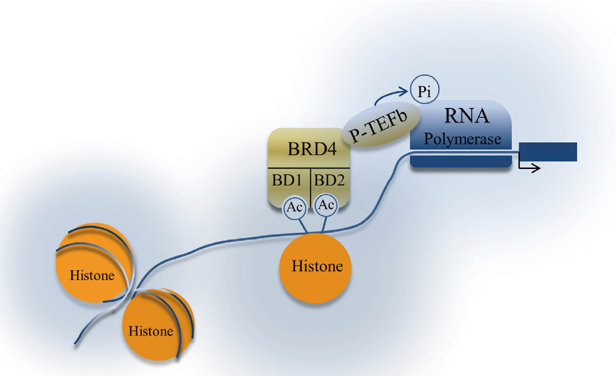
Our promise to you:
Guaranteed product quality, expert customer support.
 24x7 CUSTOMER SERVICE
24x7 CUSTOMER SERVICE
 CONTACT US TO ORDER
CONTACT US TO ORDER
BRD4 Gene Editing 
Bromodomain-containing protein 4 (BRD4) is a member of the bromodomain and extra terminal (BET) protein family that has gained wide attention in the field of cancer because of its role in the formation of super enhancers (SEs) and the regulation of oncogene expression. BRD4 plays a significant role in cellular functions such as transcription, replication, epigenetic regulation and DNA repair. It was originally identified as a chromatin-binding scaffold that can recruit transcription factors and chromatin modifiers. It also acts as a mitotic ‘bookmark’ of genes transcriptionally reactivated in early G1, including AURKB, MYC, and FOS. Studies have shown that BRD4 binds to promoters and nucleates super-enhancers, suggesting that BRD4 has an active role in gene regulation. In fact, BRD4 not only passively scaffolds transcription factors such as NF-κB and PTEFb but also actively regulates transcription elongation.
 Figure 1. BRD4 regulation of transcription. (White M E, et al. 2019)
Figure 1. BRD4 regulation of transcription. (White M E, et al. 2019)
BRD4 Dysregulation in Cancer
BRD4 gene rearrangements or BRD4 gene mutations including nonsense substitutions and missense substitutions have been documented in many human cancers. Aberrant expression of BET proteins, especially BRD4, promotes the progression of cell cycling, invasion and metastasis of cancer cell lines in vitro. For example, gene fusion events in squamous cell carcinoma cells involving BRD4 (or BRD3) and the nuclear protein in testes (NUT) gene enhances cell invasion and migration in vitro and is associated with a highly aggressive variant of this cancer, namely NUT midline carcinoma in humans. Similarly, amino acid substitutions predominantly localized to residues in the two terminal helices αB and αC and proximal to the acetyl-lysine binding site of BRD4 promote the oncogenic characteristics of BRD4. Lori et al. found that amino acid substitutions involving these regions in the BET family of proteins altered tertiary protein structure and decreased protein stability at high temperatures. These findings indicate that genetic events affecting BET family members may alter protein conformation and impact protein-protein or protein-DNA interactions, thus regulating the biological processes of tumorigenesis, development and metastasis.
BRD4 as A Promising Therapeutic Target
Brd4 expression was significantly up-regulated in non-small cell lung cancer (NSCLC) tissues and NSCLC cell lines with higher invasion and metastasis potentials. Suppression of Brd4 expression in NSCLC cell lines impaired cell invasion, inhibited cell proliferation, and accelerated cell apoptosis. More importantly, high level of Brd4 was closely related to the poor prognosis of NSCLC patients. Brd4 was highly over-expressed in primary and metastatic melanoma tissues, which is essential for melanoma tumor growth. Brd4 inhibitor treatment can rapidly down regulate key cell-cycle genes, including ERK1, SKP2 and c-Myc, and strongly attenuated melanoma cell proliferation in vitro and tumor growth and metastatic behavior in vivo. Individual silencing of Brd4 mostly recapitulated the potent anti-leukemic effects of Brd4 inhibitor-mediated suppression. It is worth noting that Brd4 inhibitor treatment remained robust effective against BRAF or NRAS mutant melanoma cells. Given the close relationship between Brd4 expression and cancers, Brd4 has been considered as a promising therapeutic target in many malignancies. Significant efforts have been made to develop pharmacological inhibitors of Brd4, and many Brd4 inhibitors have progressed to clinical and preclinical evaluation. In recent years, Brd4 degraders based on Protein proteolysis-targeting chimeras technology (PROTACs) are emerging as a novel approach for epigenetic therapy of cancers and displayed exciting antitumor efficiency.
BRD4 Gene Editing Services
CRISPR/Cas9 PlatformCB at Creative Biogene is dedicated to offering comprehensive CRISPR/Cas9 gene editing services and products for academic research, biotech research and pharmaceutical drug discovery. With deep gene editing knowledge and extensive experience in experimental operation and data processing, we help you effectively control BRD4 genes knockout/knockin/point mutation in cells or animals via CRISPR/Cas9 technology.
| Service | Details | Alternative cell lines or animal species |
| BRD4 Gene Editing Cell Line Generation | gRNA design and synthesis Transfect the cell lines you're interested Select the high expression cells and sort monoclonal cell Validate the knockout/knockin/point mutation of BRD4 by PCR and sequencing Provide cryogenically preserved vials of stable cells and final reports | HEK239T, Hela, HepG2, U87, Ba/F3, CHO, MDA-MB-453, MDA-MB-231NIH3T3, T47D, Neuro2a, MCF7, RKO, K562, RAW264.7, etc. |
| BRD4 Gene Editing Animal Model Generation | BRD4 gene conventional knockout animals BRD4 gene conditional knockout animals BRD4 point mutation animals BRD4 knockin animals | Mouse, rat, rabbit, zebrafish, C. elegans, etc. |
Related Products at CRISPR/Cas9 PlatformCB
| CATALOG NO. | PRODUCT NAME | PRODUCT TYPE | INQUIRY |
| CLKO-0720 | BRD4 KO Cell Lysate-HEK293T | Knockout Cell Lysate | Inquiry |
| CSC-RT0467 | BRD4 Knockout Cell Line-293T | Pre-Made Knockout Cell Line | Inquiry |
References
- White M E, et al. Emerging roles of and therapeutic strategies targeting BRD4 in cancer. Cellular immunology, 2019, 337: 48-53.
- Duan Y, et al. Targeting Brd4 for cancer therapy: inhibitors and degraders. MedChemComm, 2018, 9(11): 1779-1802.
- Lin S, Du L. The therapeutic potential of BRD4 in cardiovascular disease. Hypertension Research, 2020, 43(10): 1006-1014.
- Devaiah B N, et al. BRD4 is a histone acetyltransferase that evicts nucleosomes from chromatin. Nature structural & molecular biology, 2016, 23(6): 540.